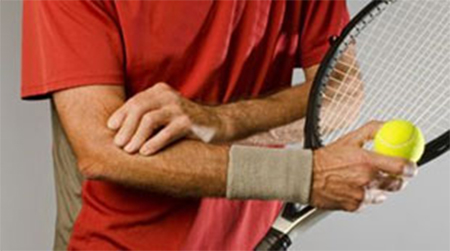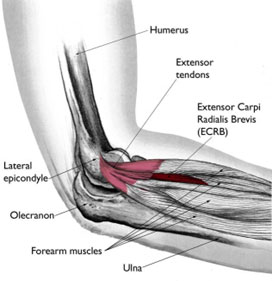Tennis Elbow (Lateral Epicondylitis)

- Lateral epicondylitis or “tennis elbow” is a common cause of elbow pain among athletes
- The muscles that extend our fingers and extend our wrist originate at the bony prominence along the outside of the elbow known as the lateral epicondyle
- Repetitive movements cause these extensor tendons to pull on the epicondyle leading to small tears in the muscles and tendons
orthoinfo.aaos.org/en/diseases--conditions/tennis-elbow-lateral-epicondylitis/ - Poor healing of these microtears leads to a chronic degeneration of the muscles and tendons ultimately resulting in nagging elbow pain
- Although commonly associated with tennis players because of the repetitive wrist extension motion, lateral epicondylitis can be seen in anyone engaging in repetitive gripping or lifting tasks. This includes athletes and laborers alike

SYMPTOMS:
- Most commonly seen in patients between the ages of 35 and 50
- Pain is typically localized to the outer part of the elbow and is worsened by repetitive gripping or lifting when the wrist and elbow are extended
- It is common to experience pain with holding or lifting objects away from the body
DIAGNOSIS:
- Lateral epicondylitis is typically a clinical diagnosis made by a thorough history and physical exam
- Pain is usually localized to the outer portion of the elbow and is tender to direct palpation
- This pain can be worsened with resisted wrist extension and resisted long finger extension. This is because these motions isolate the extensor carpi radialis brevis, the tendon typically most affected in lateral epicondylitis
- X-rays are typically normal but useful to evaluate the bony anatomy
- MRI may be helpful to determine the severity of tendon tears and degeneration as well as rule out other ligamentous injuries
TREATMENT:
- Treatment of lateral epicondylitis is dependent on a number of factors including duration and severity of symptoms. Some patients find their symptoms spontaneously resolve over a long period of time. For others, both surgical and non-surgical options are available. As a general rule, non-surgical treatment is usually considered first
NON-SURGICAL
- Activity modification: The activity exacerbating the symptoms should be limited or modified. Modifying grips or techniques, such as use of a different size racket in tennis, may relieve the problem.
- Medication: NSAIDS or Anti-inflammatory medications may help alleviate the pain
- Brace: A tennis elbow brace, a band worn over the muscle of the forearm just below the elbow, can reduce the tension on the tendon and allow it to heal. A wrist brace has also been shown to help reduce repetitive wrist extension and reduce stress across the tendons
- Physical therapy: Stretching and/or strengthening exercises, ultrasound, or heat treatments may help the pain. See attachment of stretches from the AAOS
- Steroid injections: A steroid is a strong anti-inflammatory medication that can be injected into the area
- Platelet-Rich Plasma (PRP) Injections: This includes withdrawing blood from an uninjured site and reinjecting it into the area of the lateral epicondyle
Lateral Epicondylitis Stretches
SURGICAL TREATMENT
As a general rule, surgical treatment for lateral epicondylitis is only considered when the patient is experiencing incapacitating pain that has not responded to the typical non-surgical options over a minimum period of 6-12 months
Surgical treatment consists of removing the degenerated tendon and possibly repairing healthy tendon back to the lateral epicondyle. This can be performed via several methods:
- Percutaneous debridement:
- Performed under ultrasound guidance the unhealthy degenerative tissue is selectively debrided
- Arthroscopic debridement:
- Utilizing a camera through small incisions allows for added ability to assess and address any intra-articular pathology
- Pathologic degenerative tissue is debrided, and area is stimulated to promote healing
- Open Debridement:
- Recommended in more advanced cases of lateral epicondylitis
- Involves excising the diseased tissue and repairing healthy tissue back to its origin
RECOVERY
- It is important to remember that even with surgical treatment of lateral epicondylitis recovery is excepted to take several months and full recovery can take 6-12 months. Typical immediate postoperative period includes:
- Early elbow range of motion
- Wrist splint for 4 to 6 weeks with limited strengthening
- Physical therapy to reduce swelling and pain, and to regain motion and strength
- Avoidance of gripping activities greater than 3 pounds for 2-3 months
You will need the Adobe Reader to view and print these documents. 

